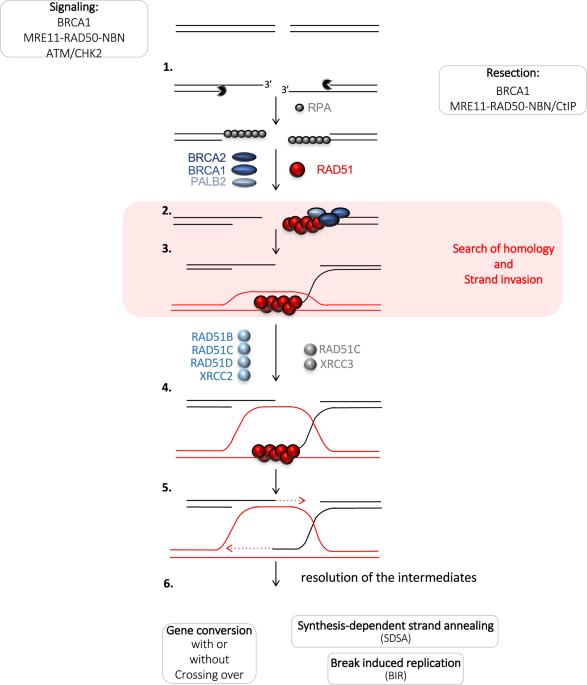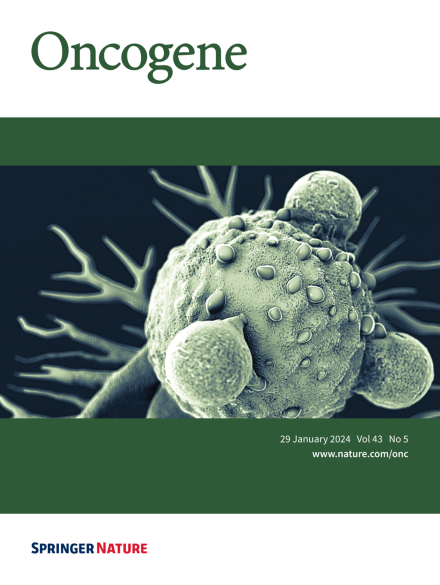rad51介导的同源重组是促肿瘤驱动通路。
IF 7.3
1区 医学
Q1 BIOCHEMISTRY & MOLECULAR BIOLOGY
引用次数: 0
摘要
遗传不稳定是癌细胞的一个特征。同源重组(Homologous recombination, HR)通过其DNA修复和复制叉的护送功能,在维持基因组稳定中起着关键作用。因此,HR被归类为肿瘤抑制通路。一致地,许多HR基因在癌症中发生突变,特别是在遗传性乳腺癌和卵巢癌中。然而,尽管RAD51控制着HR的中心步骤,但没有RAD51突变与癌症易感性相关,这构成了“RAD51悖论”。“RAD51悖论”的一种潜在解释是,癌症中影响中介/辅助基因(如BRCA1或BRCA2)的突变导致受损DNA上RAD51缺失,从而使其可以进入其他的完全诱变修复过程,如单链退火(SSA)或替代末端连接(A-EJ),这可以挽救一些细胞活力,但也增加了遗传不稳定性。这就提出了一个问题:癌症易感性实际上是由HR缺乏本身引起的,还是由其他非保守修复途径引起的。一项在小鼠模型中评估这一问题的研究表明,在不刺激SSA或a - ej的情况下,体内RAD51 HR活性的降低不仅不利于肿瘤的发生,而且可以防止肿瘤的发生。这些数据表明,rad51控制的HR不是肿瘤抑制因子,而是促进肿瘤进展。癌细胞是高度增殖的,积极地复制它们的基因组,因此受到高度复制压力;使它们能够应对这种巨大的复制压力的途径,如HR,应该有助于它们生存和增殖,这与HR作为肿瘤抑制途径的信念教条相反。我们提出,HR/RAD51通过其在克服复制应激中的重要作用,应该在早期致瘤前增生状态触发活跃的复制程序时促进癌症进展,挑战普遍接受的观点。本文章由计算机程序翻译,如有差异,请以英文原文为准。

RAD51-mediated homologous recombination is a pro-tumour driver pathway
Genetic instability is a hallmark of cancer cells. Homologous recombination (HR) plays a pivotal role in maintaining genome stability through its DNA repair and replication fork escort functions. Therefore, HR is classified as a tumour suppressor pathway. Consistently, many HR genes are mutated in cancer, especially in hereditary breast and ovarian cancer. However, although RAD51 controls the central steps of HR, no RAD51 mutations are associated with cancer predisposition, constituting the “RAD51 paradox”. One of the potential explanations for the “RAD51 paradox” is that mutations affecting mediator/accessory genes (such as BRCA1 or BRCA2) in cancer result in the absence of RAD51 on damaged DNA, leaving access to alternative exclusively mutagenic repair processes, such as single-strand annealing (SSA) or alternative end-joining (A-EJ), which can rescue some cell viability but also increase genetic instability. This raises the question of whether cancer predisposition actually results from HR deficiency itself or from alternative, nonconservative repair pathways. One study assessing this question in a mouse model revealed that decreasing RAD51 HR activity without stimulating SSA or A-EJ in vivo not only does not favour tumorigenesis but rather protects against it. These data suggest that RAD51-controlled HR is not a tumour suppressor but rather favours tumour progression. Cancer cells are highly proliferative, actively replicating their genomes, and are therefore subjected to high replication stress; pathways enabling them to cope with this massive replication stress, such as HR, should help them survive and proliferate, contrary to the belief dogma that HR acts as a tumour suppressor pathway. We propose that HR/RAD51, through its essential role in overcoming replication stress, should facilitate cancer progression as soon as early pretumorigenic hyperplasia states that trigger an active replication program, challenging commonly accepted views.
求助全文
通过发布文献求助,成功后即可免费获取论文全文。
去求助
来源期刊

Oncogene
医学-生化与分子生物学
CiteScore
15.30
自引率
1.20%
发文量
404
审稿时长
1 months
期刊介绍:
Oncogene is dedicated to advancing our understanding of cancer processes through the publication of exceptional research. The journal seeks to disseminate work that challenges conventional theories and contributes to establishing new paradigms in the etio-pathogenesis, diagnosis, treatment, or prevention of cancers. Emphasis is placed on research shedding light on processes driving metastatic spread and providing crucial insights into cancer biology beyond existing knowledge.
Areas covered include the cellular and molecular biology of cancer, resistance to cancer therapies, and the development of improved approaches to enhance survival. Oncogene spans the spectrum of cancer biology, from fundamental and theoretical work to translational, applied, and clinical research, including early and late Phase clinical trials, particularly those with biologic and translational endpoints.
 求助内容:
求助内容: 应助结果提醒方式:
应助结果提醒方式:


